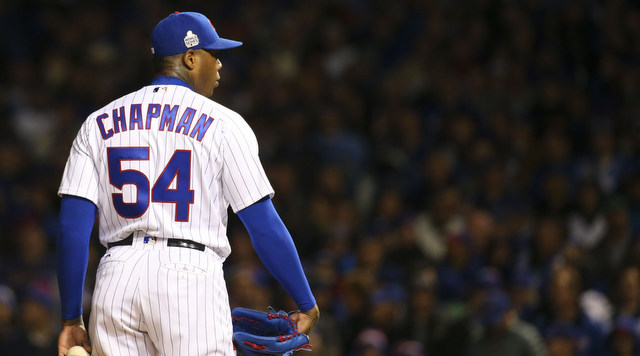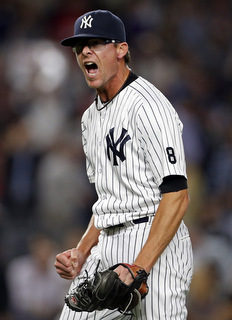
The 2016 trade deadline was, truly, a monumental event for the Yankees. The team’s mediocre on-field performance pushed ownership to give Brian Cashman the authority to sell at the deadline, something the club hasn’t done in nearly three decades. I don’t think it’s unreasonable to call this year’s trade deadline a franchise-altering event.
Will the deadline alter the franchise for the better? That’s what we’re all hoping. The Yankees made five trades in the week leading up to the deadline, four of which qualify as “seller” trades, and those trades netted them two big leaguers and 12 total prospects. After the deadline Jim Callis said the Yankees have “the deepest system in the game.” The five trades told us five different things about the Yankees.
The Chapman Trade: The Yankees Are Opportunists
The first of the five trades was the Aroldis Chapman trade with the Cubs. It happened a full week prior to the deadline. I wanted the Yankees to trade Chapman even if they were in the race. I wrote that for I don’t know how many months before the trade actually happened. The club bought low in the offseason and had a chance to sell outrageously high at the deadline.
The Yankees did exactly that. They were 50-48 on the morning of the day of the Chapman trade, and they’d just won six of their last eight games. Rather than hang on to Chapman and try to get back into the race, they were smart about their situation. Contenders around the league were lining up for Aroldis and the offers were impressive. Far better than the draft pick the Yankees would have received after the season.
The Chapman trade told us the Yankees are going to be opportunistic. They acquired him at a deep discount (for terrible off-the-field reasons) and flipped him for a massive return. Getting Gleyber Torres alone would have been a major win. The other three players are gravy. I think it’s pretty gross the Yankees used the domestic violence incident to buy low on Chapman, but the team showed when an opportunity that is too good to be true presents itself, they’re going to pounce.
The Miller Trade: Committed To The Rebuild
Okay, fine, it’s a transition, not a rebuild. Whatever. The Yankees were in a very unique position at the trade deadline because they had not one, but two top notch relievers to peddle to contenders. Chapman was the first to go. Following that deal, the Yankees took offers for Andrew Miller, as they did last offseason. And of course everyone wanted him. Pretty much every contender was in on Miller.
Unlike Chapman, the Yankees didn’t have to trade Miller. I mean, they didn’t have to trade Chapman either, but it was such an obvious move. He was an impending free agent and his value was through the roof. Miller had two more affordable years left on his contract — plus he is insanely good and very popular — and keeping him would have completely justifiable. Teams wish they could have 25 guys like Andrew Miller on their roster.
Rather than keep Miller for those reasons, the Yankees acknowledged the bullpen market had exploded, and they capitalized on the opportunity. They’re so committed to the rebuild transition that they traded exactly the kind of player they want to acquire: affordable, effective, and likeable. The timetables didn’t line up though. A top notch reliever is not what they need right now. They need Clint Frazier and Justus Sheffield more.
The Clippard Trade: A Complete Tear Down Isn’t Happening
The Yankees won’t say it, but they’re rebuilding. They’re just not rebuilding all the way. A complete Astros style tear down isn’t going to happen because a) it can’t due to some unmovable contracts, and b) ownership doesn’t want it to happen. Hal Steinbrenner has made that very clear. They want to remain in quasi-contention to keep fans interested (i.e. sell tickets, etc.).

The Tyler Clippard trade, which went down a few hours after the Miller trade, is the perfect example. Rather than turning Miller’s vacated roster spot over to a young reliever, the Yankees brought in a productive veteran to help them win. The cost was minimal — the Yankees gave up Vicente Campos, who got hurt (again) a few weeks after the trade — and the message was clear. The Yankees are still trying to win, which is commendable. There’s something to be said for refusing to be an abject embarrassment on the field.
Now, does it makes sense to try to remain competitive even though the team on the field is telling you the postseason isn’t going to happen? That’s up for debate. I’m sure some fans appreciate the wins while others would rather a slightly better draft pick and larger bonus pool. That’s not for us to decide though. The Yankees have made their position clear. They’re going to try to win while rebuilding. The Clippard trade is the latest example.
The Beltran Trade: The Yankees Aren’t Afraid To Take Risks
The Yankees made five trades prior to the deadline this year but only two actually came on deadline day. The first sent Carlos Beltran to the Rangers for three Single-A pitching prospects in a deal that was more or less inevitable. Once Chapman and Miller were traded, there was no real point in hanging on to Beltran, another impending free agent. Yeah, he was the team’s best hitter, but that also increased his trade value.
As part of the Beltran trade, the Yankees acquired right-hander Dillon Tate, the fourth overall pick in the 2015 amateur draft. Just last year. Baseball America ranked him as the 69th best prospect in baseball coming into the 2016 season. Tate’s stock took a hit in the first half because he hurt his hamstring and his velocity wavered, so much so that he sat in the upper-80s rather than the mid-90s at times. His stock was down quite a bit.
Rather than be scared away, New York targeted Tate in the Beltran trade and was willing to take on some risk in order to get premium talent. The Yankees never have access to players like Tate (and Frazier) in the draft. They never pick in the top ten. They were able to acquire that kind of talent at the deadline. To get Frazier, they gave up a great player in Miller. To get Tate, they had to roll the dice and trade their best hitter for a reclamation project. The Yankees didn’t play it safe. They’re shooting for the moon.
The Nova Trade: A Small Return Is Better Than No Return
Minutes prior to the trade deadline, the Yankees shipped Ivan Nova to the Pirates for two players to be named later. Two! That’s one more than I expected. Nova was another impending free agent, and again, there was no reason to keep him. He wasn’t a qualifying offer candidate and it wasn’t like he was pitching well either. A few teams were interested, including the Rangers, but ultimately Cashman connected with his favorite trade partner and sent Nova to Pittsburgh.
The Yankees didn’t get a whole lot for Nova. Tito Polo could maybe be a speedy fourth outfielder down the line, and Stephen Tarpley figures to get plenty of chances as a hard-throwing lefty, but neither player is likely to have much of an impact. They’re spare parts. They’re also better than nothing, which is what the Yankees would have received had they kept Nova and let him finish out the season in pinstripes. Keeping Ivan would have been pointless given the team’s place in the standings.
The Nova trade was a common sense trade. Get whatever you can and move on. Polo and Tarpley probably won’t amount to much, but you never really know. Tarpley could figure out how to throw his breaking ball for strikes, or perhaps some team wants Polo as the third piece in a trade. Point is, the Yankees had an asset in Nova whose value was rapidly approaching zero. They accepted a small return at the deadline because a small return is better than no return.
Leave a Reply
You must be logged in to post a comment.